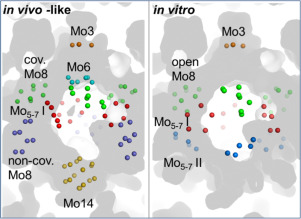Journal of Inorganic Biochemistry ( IF 3.8 ) Pub Date : 2018-09-21 , DOI: 10.1016/j.jinorgbio.2018.09.011 Steffen Brünle , Juliane Poppe , Ron Hail , Ulrike Demmer , Ulrich Ermler

|
Various N2-fixing bacteria contain a cage-like molybdenum storage protein (MoSto) that deposits more than 100 Mo as discrete polyoxomolybdate (POMo) clusters. To explore the relationship between modifiable cage properties/preparation conditions on one side and the types of POMo clusters formed on the other we established a recombinant production system for MoSto of Azotobacter vinelandii and prepared site-specifically mutated, “in vivo-like and in vitro” POMo cluster-loaded and POMo cluster-free MoSto. Seven representative X-ray structures revealed highly different POMo clusters inside architecturally rather related MoSto cages. The only significant structural difference includes a small polypeptide segment, the β-linker, which protrudes differently far into the cage interior. The β-linker is positioned outwards in in vivo-like structures of MoSto (treated with ATP and Na2MoO4 during preparation) and inwards in in vitro structures (obtained after loading the purified POMo-cluster free MoSto with ATP and Na2MoO4). Non-covalent Mo8, Mo6–7 and Mo8–14 clusters are exclusively present in in vivo-like structures. Instead, in vitro structures contain a new well-defined Mo5-7 cluster II. The digit(s) behind Mo defines the (variable) number of metal atoms in the respective POMo clusters. In comparison to the native MoSto structures the Lα131H variant is characterized by a new non-covalent Mo3 cluster and a ca. 5 Å shifted Mo5–7 cluster II, by which the covalent Mo8 cluster becomes structurally modified. Altogether, the unique bionanolab in the MoSto cage is able to create a large variety of POMo clusters by expansions, fusions and positional/orientational variations of a few discrete polynuclear Mo-O building blocks.
中文翻译:

钼储存蛋白—用于创建实验可改变的聚氧钼酸盐簇的Bionanolab
各种固定N 2的细菌都包含一个笼状的钼存储蛋白(MoSto),该蛋白以离散的聚氧钼酸盐(POMo)簇的形式沉积超过100Mo。为了探索一侧可改变的笼子性质/制备条件与另一侧形成的POMo簇类型之间的关系,我们建立了葡萄固氮菌MoSto的重组生产系统,并制备了位点特异性突变的“体内样和体外””加载了POMo群集且没有POMo群集的MoSto。七个具有代表性的X射线结构揭示了在结构上相对相关的MoSto笼子内的POMo簇非常不同。唯一的显着结构差异包括一个小的多肽片段,即β-接头,以不同的方式伸入笼子内部。β-接头在MoSto的体内类结构中向外定位(在制备过程中用ATP和Na 2 MoO 4处理),在体外结构中则位于内部结构中(在将ATP和Na 2 MoO装入纯化的无POMo簇的MoSto中后获得)4)。非共价Mo8,Mo6-7和Mo8-14簇仅在体内存在样的结构。相反,体外结构包含新的定义明确的Mo5-7簇II。Mo后面的数字定义各个POMo簇中金属原子的(可变)数目。与天然MoSto结构相比,Lα131H变体的特征在于新的非共价Mo3簇和一个ca。5Å移动了Mo5-7簇II,共价Mo8簇通过结构II进行了修饰。总而言之,MoSto笼中独特的bionanolab能够通过扩展,融合以及几个离散的多核Mo-O构建块的位置/方向变化来创建各种各样的POMo簇。











































 京公网安备 11010802027423号
京公网安备 11010802027423号